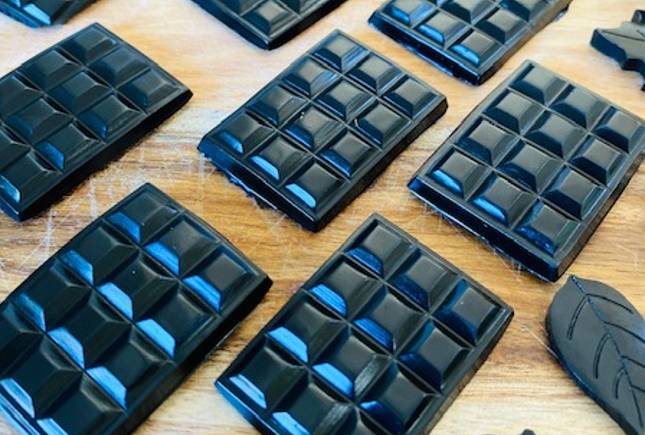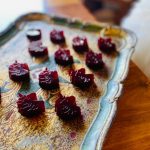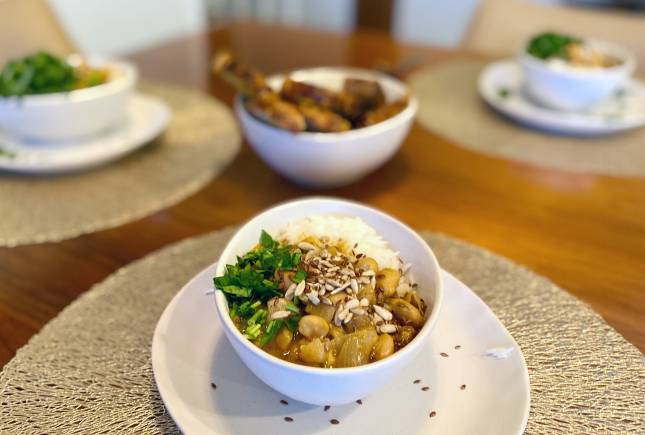Today I’m exploring a super yummy way to heal your gut with gummies. All sorts of gummies, anti-inflammatory gummies, soothing and demulcent gummies and more. In a clinical setting we call them ‘pastilles’….am I making you hungry? And they’re combinations of herbs, water and gelatin. But let’s not do anything by halves here! I’ve got some amazing recipe ideas for you and we’ll add in some extra healthy ingredients to make sure you get colourful, good consistency gummies at the end of this gustatory fling!
These gummies can become a healing treat. They’re not desired to be cures or have the effects of a drug medicine. But they’re supportive to gut health and a great way to incorporate more medicinal foods into your diet.
Since time immemorial, herbalists have focused on gut health as a foundational pillar to health. Think about it this way, the digestive process is central not only to what we put in our mouths but also to what we hear with our ears, see with our eyes, touch with our skin…
Your gut is alive and sensitive to every perception be it physical, visual, auditory or sensed. How we digest our food is a reflection of how we digest what’s happening in our worlds. So when disharmonies start arising in the body, I like to head to the gut to work out how the body is expressing its dis-ease.
In clinic I see a host of gut conditions with all ages, male and female. They tend to fall into four categories which I’ll discuss here to give you a bit of background. But I’m keen to share these recipes with you so soon enough we’ll enter the apothecary. There’s one gummy recipe for each type of gut disorder. Note that the way I approach gut health may not be the same as other natural therapists.
Four manifestations of Gut Disharmony

Naturopathic perspective: Four manifestations of Gut Disharmony (Sze, 2022)
Inflammatory gut conditions
Gut conditions with an inflammatory nature may be caused by increased gut lining permeability (leaky gut), infections, poor gut flora and may have an auto-immune foundation. Flora changes and auto-immunity actually go hand-in-hand. It’s thought that our increasingly sterile and hygiene-obsessed lifestyles are causing changes in our gut flora and provoking a more reactive and ‘belligerant’ immune response when we do encounter pathogens.
Examples of inflammatory gut conditions include :
- Inflammatory bowel disease
- Ulcerative colitis
- Crohn’s disease
- Bowel cancer
For this and all the other gummy recipes, read the instructions on how to prepare the ‘herbal extract’ first, then head to the end of the article for the remaining steps and ingredients. Enjoy!
Recipe 1: Licorice and Calendula gummies for inflammatory gut conditions

(Sze, 2022)
You’ll find organic Licorice (Glycyrrhiza glabra) root at most health stores as a tea. If you can’t find it, consider buying a pre-made Licorice tea. Most supermarkets stock Blackadder Licorice and Peppermint tea and you can use that here in place of Licorice if you like. Calendula (Calendula officinalis) is also available at health food stores. Buy the flowers or petals. The sweetness of Licorice makes these a real treat!
The Licorice and Calendula together provide anti-inflammatory activity, in a dietary dose (not a therapeutic dose) that can be incorporated into your diet to provide gentle anti-inflammatory support. The glycerine with its viscous nature soothes and helps the medicinal herbs stick to the lining of the gut. This is a soothing and calming recipe for a hot, angry or irritated gut.
To make the herbal extract you’ll need:
- 15 grams dried Licorice root (Glycyrrhiza glabra)
- 5 grams dried Calendula flower (both whole flowers or petals are fine) (Calendula officinalis)
How to prepare the herbal extract:
Saturate the herbs in a cup of room temperature (not hot) water and leave in the fridge overnight, covered. Strain the next morning and your herbal extract is cold and ready to use. Then follow the basic gummy recipe below. I used Beet juice for my batch here instead of apple juice, but I think apple juice is better as it helps with absorption.
Anxiety gut conditions
Ahhh yes, the ugly head of stress. Persisting stress wears the gut down causing indigestion, reactive digestion and worsening stress-tolerance. So in anxiety-based gut conditions think about symptoms or chronic illnesses that may not look like a gut disorder, but certainly originate (in part or fully) from one. Things like:
- Anxiety
- Depression
- Chronic eczema
- Abdominal flatulence, cramping and pain
- Irritable bowel syndrome
- Chronic fatigue
- Allergies and intolerances (to foods mainly)
Also bear in mind, the digestive system processes every perception we’re exposed to, be it gustatory, emotional, visual or otherwise. Anything that irks you or makes you feel uneasy it having an effect on your digestion.
Recipe 2: Peppermint and Chamomile calming gummies
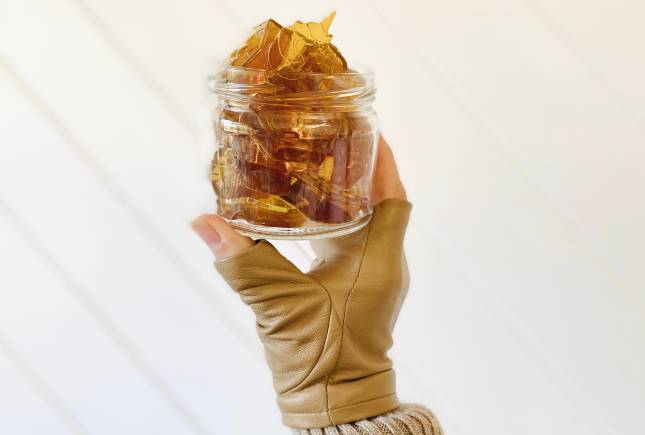
Peppermint and Chamomile Calming Gummies (Sze, 2022)
Peppermint contains a volatile oil that is rich in the compound L-menthol, which reduces gastro-intestinal spasm and offers antimicrobial, anti-inflammatory and anaesthetic effects to boot. However, volatile oils can evaporate easily if you leave the infusion uncovered. So use warm water (not freshly boiled), and ensure you leave it covered overnight to get a nice strong extract.
Chamomile provides warmth and bitterness and support the antispasmodic activity of the peppermint. So this one’s all about reducing flatulence and calming spasm. It’s particularly suited to IBS-D (diarrhoea dominant) as the peppermint also have a drying effect. A systematic review in 2019 (Alammar et al) meta-analysed (i.e analysed the results of multiple trials simultaneously to achieve an average of efficacy) to conclude that IBS patients who use peppermint oil were 2.39 times more likely to see symptom improvements like less spasm, pain and bloating compared to those who don’t. In other words, 1 out of every three IBS patient who takes peppermint oil will experience fewer symptoms. Sounds good! In summary, peppermint assists in IBS because it:
- Fights bacterial, viral and fungal gut infections
- Reduces gut inflammation associated with IBS
- Reduces abdominal bloating, pain, spasm and discomfort
Avoid high doses of Peppermint if you have biliary obstruction or severe liver disease.
So let’s see what’s in this gut-pleasing delight…. To make your herbal extract you’ll need:
- 4 organic Peppermint leaf teabags or approximately 8 grams dried Peppermint leaves
- 1 organic Chamomile flower teabag or approximately 2 grams dried Chamomile flowers
How to prepare the herbal extract: Saturate the herbs in a cup of warm water and leave in the fridge overnight, covered. Strain the next morning and your herbal extract is cold and ready to use. Then follow the basic gummy recipe below.
Note: Why I’m not using peppermint essential oil. Although some commercial enterprises may suggest ingesting essential oils internally, this a no-no in my book for these reasons:
- There’s no formal training in Australia that provides the skill and knowledge for anybody to prescribe essential oils for ingestion safely or efficaciously.
- The regulatory body for medicinal products in Australia (TGA) to this day have not approved internal ingestion of essential oils unless they are commercially manufactured and processed to ensure their safety.
- The study of herbal chemistry (pharmacognosy) tells us that essential oils have potent antiseptic, irritant, anti-bacterial and other effects that can damage the mucous membranes of your digestive system including your throat and mouth. They also irritate the kidneys. Herbalists prescribe the whole plant to ensure the quantity of essential oils in medicines is always safe and relative to the other chemicals in the plant, but when you tip those drops straight out of an essential oil bottle, that’s different. Just don’t do it friends!
Auto-immune gut conditions
Gut conditions with an auto-immune nature are driven by an increasingly belligerent and hyper-responsive immune system in conjunction with poor gut lining strength and gut flora changes. Leaky gut is commonly seen here, and it allows infective pathogens to move through the gut with ease, triggering the immune system. As your immune system ramps up the production of auto-antibodies and inflammation keeps increasing, it makes it harder for gut healing to take place.
Symptoms progressively get worse while you get more fatigued, inflamed and unwell. These conditions manifest a large amount of inflammation in the body so the natural approach to working with both auto-immune and inflammatory gut conditions is quite similar. Examples of auto-immune conditions are:
- Coeliac disease
- Food allergy and intolerances
- Crohn’s disease
- Ulcerative colitis
I had to really think hard about this one for herbs because lots of the herbs I use in auto-immune disease are a bit exotic (not easy to get hold of) and others like Turmeric aren’t well absorbed as gummies. So I’ve settled on an old favourite, Marshmallow root.
The mucilage in Marshmallow root (Althaea officinalis) is soothing, cooling, calming on the mucous membranes of the gut while it gently heals them. This is the best herb to mend those damaged and frayed gut linings. It’s this lack of intestinal barrier function that’s thought to cause autoimmune disease in the first place. You’ll find dried Marshmallow root at your local health shop or online.
Ashwagandha assists with healing as well as modulating immune function to regain balance. If you can’t get hold of Ashwagandha root, you can try Stinging Nettle leaf in its place. Nettle is also useful in healing mucosa and autoimmune gut disease. Know that immune system protocols can be complex and nuanced so its best to see a Naturopath or Herbalist and get on to a serious protocol designed to remedy autoimmunity. In the meantime, you can snack on these for some gentle support.
Recipe 3: Marshmallow and Ashwagandha healing gummies

Marshmallow and Ashwagandha gummies (Sze, 2022)
To make your herbal extract you’ll need:
- 15g Marshmallow root (Althaea officinalis)
- 10g Ashwagandha (Withania) root (Withania somnifera)
How to prepare the herbal extract: Saturate the herbs in a cup of warm water and leave in the fridge overnight. Strain the next morning and your herbal extract is cold and ready to use. Then follow the basic gummy recipe below.
4. Toxicity Induced Gut Conditions
Feeling toxic? Sluggish? Ready for a bit of a cleanse? Well clean never looked blacker! I have a tasty treat that going to get to work on clearing out depurities from your gut. Sound good? Read on to learn how charcoal is about to become your tummy buddy.
Toxicity induced gut symptoms are driven by poor diet mostly, but also triggered by infections and the things like gut flora degradation after infections and antibiotic use. Toxic load increases internally which creates undesirable changes in your gut flora and digestive strength. Other detoxification systems like the liver, kidneys and skin particularly struggle with toxic load in the gut. So you might find you feel sluggish, tired, nauseous or you suffer from skin breakouts, eczema, rash or psoriasis. The symptoms of a toxic gut are many and varied:
- Constipation persisting for 3 months or more
- Abdominal distension
- Small Intestinal Bacterial Overgrowth (SIBO)
- Candida (intestinal) overgrowth
- Smelly flatulence (wind)
- Weight gain and slow metabolism
- Constipation
- Fatigue
- Mood changes
- Poor concentration and cognitive power
Charcoal is a great toxin absorber. It binds to toxins in the digestion system and moves them out of the body into the stools. So expect dark stools when you take this black powder! It’s used to alleviate intestinal gas, for drug overdoses under professional supervision, to prevent or manage travel-related infections and tummy bugs and to reduce diarrhoea. Studies show activated charcoal not only reduces abdominal pain and bloating, but also prevents damage to the gut mucosa after antibiotic therapy. There’s more! A hypothetical paper was published last year (Khitan et al, 2020) proposing the use of charcoal in Covid-19 patients to reduce systemic damage and stress caused by the pro-oxidative disease. This related to the ability of charcoal to bind to, and remove toxins associated with the disease.
Recipe 4: Charcoal gummies to detoxify your gut
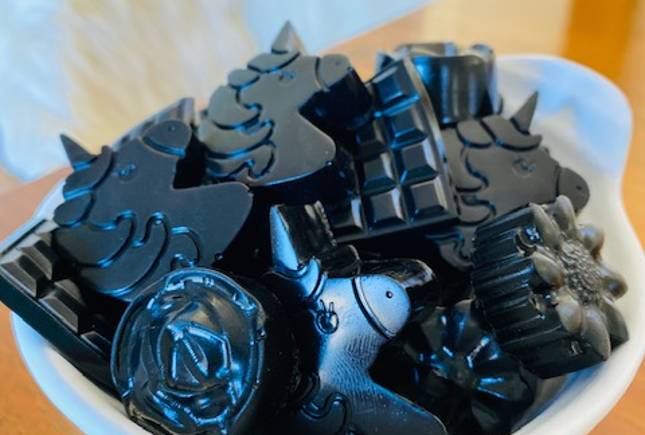
Charcoal gummies (Sze, 2022)
To make these gummies you’ll need:
- 3 Tbsp Activated Charcoal (or 30 grams)
No need to prepare a herbal extract for this one, just go ahead add your charcoal to 150mL of water. Instead of apple juice, I recommend using grape juice in these.
*Don’t exceed 50 grams of activated charcoal daily.
And we’re nearly ready for the generic gummy recipe now but first…
The health benefits of gelatin and glycerine
Before we get to this amazing gummy recipe, let me tell you about the extra health benefits you’ll be getting from the other ingredients. Get your cotton-string shopping bags ready because you’ll be making a bee line for these pretty soon methinks!
Gelatin
Our friend gelatin gets around. It’s used in foods as a gelling agent and edible film, in cosmetics bath salts, shampoos, sun lotions, face creams, hair sprays, and also in air filters, wine making, syrup making. You’ll find gelatin in those amazing bone broths that are so great for chronic gut disorders too. Gelatin’s also used to make commercial gummy lollies but they’re also full of sugar, flavourings and preservatives and we want none of that – it’s natural, unflavoured gelatin that will give a number of health benefits.
Gelatin settles digestion and assists with milk and protein metabolism. It’s derived from collagen, the most abundant protein in the body which naturally resides in bone, skin, tendons and ligaments. So taking gelatin helps build up all of these inside your body. It’s been shown to reduce symptoms of colitis and inflammation in the colon as well as improving skin elasticity and strength. As a proven antioxidant, gelatin may be useful for a range of conditions associated with chronic oxidation like heart diseases, neurodegenerative diseases, chronic obstructive pulmonary disease and chronic kidney disease.
Being rich in amino acids like glycine and proline, gelatin helps build neurochemicals (think serotonin, dopamine and acetylcholine) which are so important for memory, mood and cognition. Studies show this is why its so beneficial in insomnia, Parkinson’s disease and Alzheimers. And finally, it’s fat and cholesterol free!
Glycerin
Glycerin (also called Glycerol) is a hydration agent for your intestinal mucosa. It’ll draw and hold moisture on the tissues, which is so important for their healing. It’s also sweet tasting and helps with the consistency of your finished gummies. Where constipation exists, glycerine helps get things moving! It’s clear and liquid, but very viscous.
It might take a few extra moments to find glycerine on the shelves at your local grocers but it’s worth it. When you buy it, make sure it says ‘food grade’ or ‘B.P’ on the bottle. If not, it may be a topical use glycerine rather than a food grade one.
Recipe time!
Here’s the basic recipe which you can use to make each of the four gummies. Nice and easy my friends! Just substitute the ‘herb’ for the herbal ingredients assigned to each type of gummy. If you’re using a plant based gelatin, you need to first check the manufacturers recommendations on how to much to use in place of animal gelatin.
Basic Gummy Recipe
Equipment
- 1 Mixing bowl
- 1 small saucepan
- 1 mold for the gummies If you don't have a mold you can set the gummies in a large block and chope to size once cold and firm.
Ingredients
- 150 mL Herbal Extract (see extract for each recipe or use grape juice for Charcoal gummies) (see extract for each recipe or use grape juice for charcoal gummies)
- 100 mL Clear Apple Juice you can also use grape juice for the charcoal gummies
- 2 Tbsp Gelatin powder
- 30 mL Glycerine Food grade
- 2 Tbsp Maple Syrup (or agave or coconut syrup are also great)
Instructions
- Prepare your herbal extract and when it’s ready, strain it to remove all the plant parts
- Pour the herbal extract into a medium sized mixing bowl and pop it in the fridge if not already cooled. Once cold, sprinkle the gelatin on top and leave for 5 minutes to bloom.
- Pour the juice into a small saucepan and warm on the stove until hot (but not boiling). Once hot, turn off the heat and cover.
- Take the herbal extract out of the fridge and the gelatin will have bloomed now. You can pour in the hot juice, then the glycerine and maple syrup and whisk (by hand) to gently combine. Once combined, pour into molds.
- Leave the molds in the fridge for at least 2 hours to set.
Shelf life: 1 month in the fridge or 2 weeks on the shelf in a cool, dry place.
You’ll have 3-5 days worth of gummies in each batch here, so just work out how many gummies you make and spread that over the timeframe. As I mentioned before, they’re supplementary and not intended to replace prescribed medicines. The idea is you have a snack that’s both healthy and health-inducing. So you can really just enjoy them as a treat throughout the day!

If you liked this post you’ll love Throat soothing Elderflower Gummies in 4 easy steps

Hey there! Welcome to my world of totally natural and powerful healing medicines. Medicines from nature. Medicine from Source. I’m a naturopath and herbalist with extensive clinical experience working with a range of health conditions including hormonal, metabolic, mental health, sleep and more.
I’ve brought together years of clinical and teaching experience, academic skill and curiosity to bring you this blog. I hope you enjoy it! If you do, leave a comment, I’d love to hear from you!

References
- Fasano, A., & Shea-Donohue, T. (2005). Mechanisms of disease: the role of intestinal barrier function in the pathogenesis of gastrointestinal autoimmune diseases. Nature clinical practice Gastroenterology & hepatology, 2(9), 416-422.
- Alipal, J., Pu’ad, N. M., Lee, T. C., Nayan, N. H. M., Sahari, N., Basri, H., … & Abdullah, H. Z. (2021). A review of gelatin: Properties, sources, process, applications, and commercialisation. Materials Today: Proceedings.
- Wu, G., Bazer, F. W., Burghardt, R. C., Johnson, G. A., Kim, S. W., Knabe, D. A., … & Spencer, T. E. (2011). Proline and hydroxyproline metabolism: implications for animal and human nutrition. Amino acids, 40(4), 1053-1063.
- Razak MA, Begum PS, Viswanath B, Rajagopal S. Multifarious beneficial effect of nonessential amino acid, glycine: a review. Oxidative medicine and cellular longevity. 2017 Jan 1;2017.
- Bannai, M., & Kawai, N. (2012). New therapeutic strategy for amino acid medicine: glycine improves the quality of sleep. Journal of pharmacological sciences, 118(2), 145-148.
- Proksch, E., Segger, D., Degwert, J., Schunck, M., Zague, V., & Oesser, S. (2014). Oral supplementation of specific collagen peptides has beneficial effects on human skin physiology: a double-blind, placebo-controlled study. Skin pharmacology and physiology, 27(1), 47-55.
- Liguori, I., Russo, G., Curcio, F., Bulli, G., Aran, L., Della-Morte, D., … & Abete, P. (2018). Oxidative stress, aging, and diseases. Clinical interventions in aging, 13, 757.
- Rubio IG, Castro G, Zanini AC, Medeiros-Neto G. Oral ingestion of a hydrolyzed gelatin meal in subjects with normal weight and in obese patients: Postprandial effect on circulating gut peptides, glucose and insulin. Eat Weight Disord. 2008 Mar;13(1):48-53. doi: 10.1007/BF03327784. PMID: 18319637.
- Peitl, V., & Vlahović, D. (2020). Glycine transporter inhibitors. Archives of Psychiatry Research: An International Journal of Psychiatry and Related Sciences, 56(1), 83-86.
- Bowery, N. G., & Smart, T. G. (2006). GABA and glycine as neurotransmitters: a brief history. British journal of pharmacology, 147 Suppl 1(Suppl 1), S109–S119. https://doi.org/10.1038/sj.bjp.0706443
- Deng, Z., Cui, C., Wang, Y., Ni, J., Zheng, L., Wei, H. K., & Peng, J. (2020). FSGHF3 and peptides, prepared from fish skin gelatin, exert a protective effect on DSS-induced colitis via the Nrf2 pathway. Food & function, 11(1), 414-423.
- Alammar, N., Wang, L., Saberi, B., Nanavati, J., Holtmann, G., Shinohara, R. T., & Mullin, G. E. (2019). The impact of peppermint oil on the irritable bowel syndrome: a meta-analysis of the pooled clinical data. BMC complementary and alternative medicine, 19(1), 1-10.
- Colomier, E., Algera, J., & Melchior, C. (2021). Pharmacological Therapies and Their Clinical Targets in Irritable Bowel Syndrome With Diarrhea. Frontiers in Pharmacology, 11, 2464.
- Khan, I., Ullah, N., Zha, L., Bai, Y., Khan, A., Zhao, T., … & Zhang, C. (2019). Alteration of gut microbiota in inflammatory bowel disease (IBD): cause or consequence? IBD treatment targeting the gut microbiome. Pathogens, 8(3), 126.
- Fasano, A. (2020). All disease begins in the (leaky) gut: Role of zonulin-mediated gut permeability in the pathogenesis of some chronic inflammatory diseases. F1000Research, 9.
- Xu, H., Liu, M., Cao, J., Li, X., Fan, D., Xia, Y., … & Zhao, H. (2019). The dynamic interplay between the gut microbiota and autoimmune diseases. Journal of immunology research, 2019.
- Mu, Q., Kirby, J., Reilly, C. M., & Luo, X. M. (2017). Leaky gut as a danger signal for autoimmune diseases. Frontiers in immunology, 8, 598.
- Mari, A., Backer, F. A., Mahamid, M., Amara, H., Carter, D., Boltin, D., & Dickman, R. (2019). Bloating and abdominal distension: clinical approach and management. Advances in therapy, 36(5), 1075-1084.
- Khitan, Z. J., Khawaja, I., Mufson, M. A., Sanabria, J. R., Abraham, N. G., Peterson, S. J., … & Shapiro, J. I. (2020). Can charcoal improve outcomes in COVID-19 infections?. Medical hypotheses, 144, 110176.
- Fehér, C., Soriano, A., & Mensa, J. (2017). A Review of Experimental and Off-Label Therapies for Clostridium difficile Infection. Infectious diseases and therapy, 6(1), 1–35. https://doi.org/10.1007/s40121-016-0140-z

